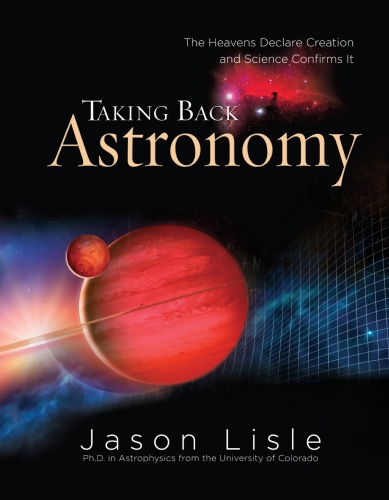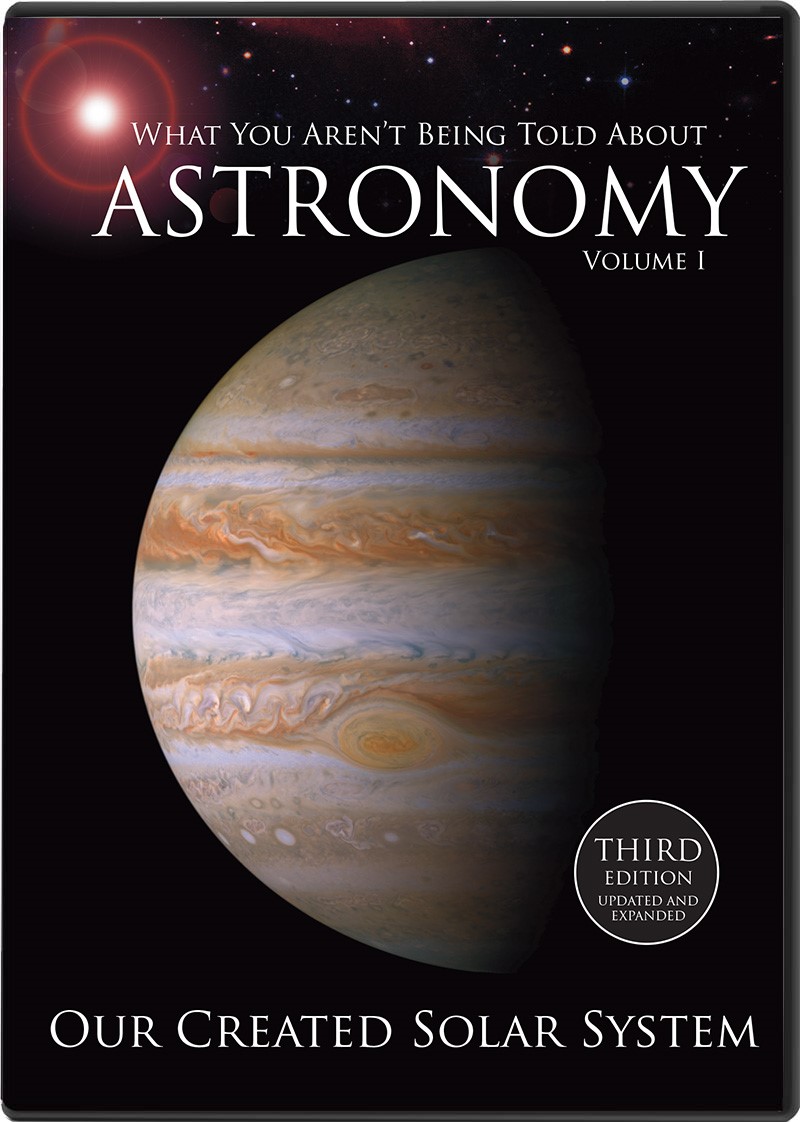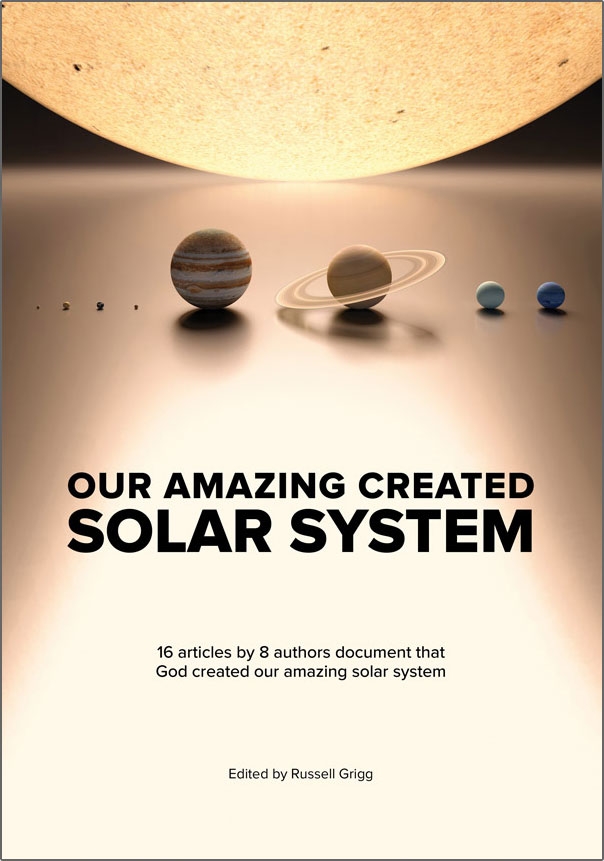Journal of Creation 37(3):6–8, December 2023
Browse our latest digital issue Subscribe
Saturn’s changing rings
In 2017 the Cassini spacecraft finished its mission at Saturn by making 22 orbital passes between Saturn’s D ring and the cloud tops of Saturn itself. This has been called ‘Cassini’s grand finale’. In the ‘grand finale’, the Cassini spacecraft flew just 1,600 to 4,000 km (1,000–2,500 mi) above Saturn’s clouds. After making these passes over Saturn’s clouds, it ran out of fuel and fell into Saturn. The Cassini mission provided a great deal of information about Saturn, its moons, and its amazing rings. Secular scientists long assumed that Saturn’s rings were of the same age as the planet, which they would say was 4.6 Ga. But for years creationists have written about evidence for Saturn’s rings being much younger.1,2,3 Other facts regarding the Saturn system have also been addressed by creationists as confirmations of a biblical creation view.4,5
But how should we understand Saturn’s rings? Is the age of the rings the age of the planet? Saturn’s rings are very dynamic and complex; they can change over periods of just a few hours in some details. Naturalistic scientists assume our solar system to be 4.6 Ga in age, having formed out of a spinning disc of gas and dust. But in recent years planetary scientists have acknowledged growing evidence that Saturn’s rings are much younger than the alleged old age of Saturn and have thus come to a general consensus that Saturn’s rings did not form with Saturn but formed much later.5
The Cassini mission to Saturn provided more definitive data regarding the mass and density of the rings of Saturn, meteoritic dust falling on the rings, particulate and vapour material falling into Saturn (ring rain), and the composition of the rings. Saturn’s main rings are approximately 5 m thick from the inner edge of the C ring going outward to the outer edge of the A ring, which is 30 m thick (figure 1).6 These thicknesses do not apply to the F, G, and E rings outside the A ring, since they consist of diffuse dust. In the main rings (A, B, and C) the ring objects range mostly from about 1 cm to 10 m in size.7 The Cassini mission refined the mass estimate of Saturn’s rings to be 40% of the mass of the moon Mimas.8 The main rings are the A, B, and C rings, which do not have large amounts of dust. However, the inner D ring and the outer F, G, and E rings have more dust. In composition, the ring objects are estimated to be more than 95% water ice.8 There are also small concentrations of other substances that fall on the rings, often referred to as ‘pollution’.
Slightly polluted rings
One study from Zhang et al.,7 in 2017, estimated the amount of nonicy material that impacted on the rings from hypervelocity micrometeoroids for Saturn’s A and B rings, and the Cassini Division. This used microwave radiometry from the Cassini spacecraft. This method involved measuring the degree of scattering of the microwaves based on reasonable assumptions of the type of particles falling on the rings’ icy objects and how they transferred across the rings. This estimates the rate that micrometoritic material is being added to the icy ring objects. Zhang et. al. summarized their results as follows:
“The pollution exposure time in the B ring, Cassini Division and A ring all lie between ~10–150 Myr, which is also consistent with the exposure time due to micrometeoroid bombardment we derived for the inner and outer C ring. These results taken together support the idea that Saturn’s rings are geologically young, 150 Myr old, further suggesting a formation scenario in which the rings are derived from the relatively recent breakup of an icy moon, perhaps of Mimas’ mass … .”7
Additional research has been done since 2017 which looks into two other phenomena to estimate the age of Saturn’s rings. One aspect is to estimate the effects of meteorites, ions from interplanetary space, and other particles from the moons as they impact ring objects. This leads to what’s called ballistic transport. Ballistic transport in Saturn’s rings occurs when a small impactor strikes a ring object, and ejecta is scattered from the impact. This ejecta scatters predominately in the prograde direction (the direction of rotation of the rings around Saturn). But it also has other effects. These small impacts cause a small loss of angular momentum that affects the orbit of the ring object impacted. The ring object that is impacted may also lose a small amount of mass from the impact. Thus, as impact ejecta is scattered across the rings, it tends to cause multiple ring objects to drift inward due to loss of angular momentum. The ejecta may also kick up other particles. This leads to some particles drifting inward and falling into Saturn’s upper cloud layers. This becomes an age indicator from a) the erosion of the ring objects by the impacts, and b) the transport of particles and even some vapours inward to Saturn. Impacts on moons that are within or near the rings of Saturn possess a large fraction of their mass as ice, and some of them can possess some organic compounds. Thus, some gases may transport inward to Saturn’s clouds as well. These transport processes have been studied by scientists very seriously since the end of the Cassini mission. The ‘grand finale’ also provided direct closeup spectrometry for particles between the inner D ring and Saturn. The Cassini spacecraft also sent some data from within the upper layers of Saturn’s clouds even as it descended into the planet.
Influx to Saturn
Durisen and Estrada8 do an analysis of the impacting particles as well as the ejecta in ballistic transport across Saturn’s rings. Instruments used on the Cassini spacecraft for this include the Cassini Cosmic Dust Analyzer (CDA) and the Cassini Ion and Neutral Mass Spectrometer (INMS). The Cosmic Dust Analyzer found that the likely source of the impactors affecting the Saturn system was the TransNeptunian region. The micrometeoroid particles do not travel at the higher speeds that would make them like longperiod comets, and their composition is more like TransNeptunian objects as well. This aspect was not what scientists expected. It had been thought they would have their source in the Oort cloud. Durisen and Estrada describe their observations:
“The Cassini Ion Neutral Mass Spectrometer (INMS) experiment, which measured the composition of Saturn’s equatorial upper atmosphere and its interactions with material originating from the rings, found a surprisingly large mass influx of between 4,800 and 45,000 kg/s within a latitude band 8° near the equator … . In addition to observing the infall of water, substantial amounts of volatiles and impact fragments of organic nanoparticles were also measured.”8
The above study made estimates regarding the average number of ejecta particles generated per impactor, the numbers of particles that can jump from one region to another in the rings, and other factors. There are a number of uncertainties in these estimates, but the data from Cassini does provide a basis for such calculations. The D ring (figures 1 and 2) lies inside the C ring and is the ring closest to Saturn’s clouds. Thus, C and D would be expected to be the rings with the lowest ‘lifetimes’. It is thought that the C ring provides some replenishment of the D ring. In fact, it is suggested that the D ring could disappear and reappear on short time frames such as a year or a few years, due to events occurring in the rings. Durisen and Estrada summarize the results of their analysis:
“From our own estimates of the mass inflow rates due to BT [ballistic transport] alone … we can calculate the remaining ring lifetime. Taking the current ring mass to be 0.4 Mimas masses … or ~1.5 × 1019 kg, we find that the range of times for the remaining mass of the rings to fall into the planet is … ~150 to 400 Myrs.”8
Thus, the new data from the Cassini mission points to the conclusion that significant material is being added to Saturn’s atmosphere. This phenomenon is generally referred to as ‘ring rain’. Another qualitative confirmation of this comes from a study of the composition of the particles and gases present in Saturn’s atmosphere. The ‘grand finale’ for Cassini included five months during which the spacecraft passed between the D ring and Saturn. This meant that Cassini actually passed through the top layers of Saturn’s atmosphere in its last five orbits. Scientists expected that the only gases from Saturn that would be encountered would be H2, atomic hydrogen, and helium. It was assumed that other heavier gases from Saturn would be present only in deeper layers. However, the INMS instrument detected other molecules, including methane, water, ammonia, carbon monoxide, carbon dioxide, and molecular nitrogen (N2), along with other hydrocarbons, and dust.9 These gas and vapour molecules would significantly affect the observed composition of Saturn’s upper atmosphere over billions of years. But this effect on the composition is not observed, even though the influx of these materials is very significant. Therefore, this is another confirmation of the rings being young.
Implications and conclusions
Due to the definitive data from Cassini, there is no longer an option for naturalistic scientists assuming an old age for the solar system to say Saturn’s rings formed with the planet. They have accepted that Saturn’s rings must be much younger than the planet. One research team separate from Durisen, above,10 said the following:
“We find that the ring exposure age for the current mass influx into the Saturnian system does not allow the rings to be formed together with Saturn and its satellites … nor slightly later during the Late Heavy Bombardment … . Saturn’s current rings cannot be primordial.”10
Therefore, scientists are now forced to investigate various catastrophic breakup or collision scenarios to explain the formation of the rings. It is also common for scientists to suggest that Saturn’s rings were at one time more massive than they are today.
To youngage creationists, however, it is still a valid option to think of Saturn’s rings as created with Saturn in the Creation Week only several thousand years ago. This still agrees with the latest data from Cassini. On the other hand, a biblical creation perspective may not require making the assumption that the rings were created with the planet. The ring age determinations above are rough upper limits, so the true age of the rings could be younger. Creationists should not understand Saturn’s rings as if every feature we see was created in the Creation Week as we see them today. The Cassini data may suggest some event or events in the past since creation that caused micrometeoroid impacts in the outer solar system. There are a number of ongoing phenomena in Saturn’s rings that are explicable by well understood physics and which do not require millions or billions of years. There is a need for more research from creationists to clarify what processes can feasibly take place in timeframes on the order of 6,000 years.
References and notes
- Snelling, A., Saturn’s rings shortlived and young, J. Creation 11(1):1, 1997. Return to text.
- Henry, J., The age and fate of Saturn’s rings, J. Creation 20(1):123–127, 2006. Return to text.
- Coppedge, D., Latest Cassini findings confirm: Saturnian system is young, Creation 42(2):25–27, 2020. Return to text.
- Psarris, S., Saturn—the ringed planet, Creation 30(4):18–20, 2008. Return to text.
- Grigg, R., The planets are young: 4. Saturn, creation.com, accessed 5 Aug 2023. Return to text.
- Williams, D.R., Saturnian rings fact sheet, nasa.gov, accessed 6 Aug 2023. Return to text.
- Zhang, Z. et. al., Exposure age of Saturn’s A and B rings, and the Cassini Division as suggested by their nonicy material content, Icarus 294:14–42, 15 Sep 2017. Return to text.
- Durisen, R.H. and Estrada, P.R., Large mass inflow rates in Saturn’s rings due to ballistic transport and mass loading, Icarus 400:115221, 9 May 2023. Return to text.
- Moses, J.I. et. al., Saturn’s atmospheric response to the large influx of ring material inferred from Cassini INMS measurements, Icarus 391:115328, Feb 2023. Return to text.
- Kempf, S. et. al., Micrometeoroid infall onto Saturn’s rings constrains their age to no more than a few hundred million years, Science Advances 9(19), 12 May 2023. Return to text.





Readers’ comments
Comments are automatically closed 14 days after publication.